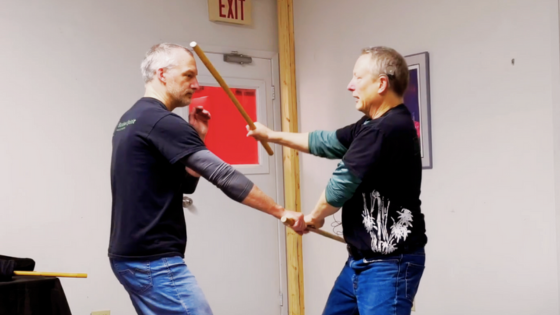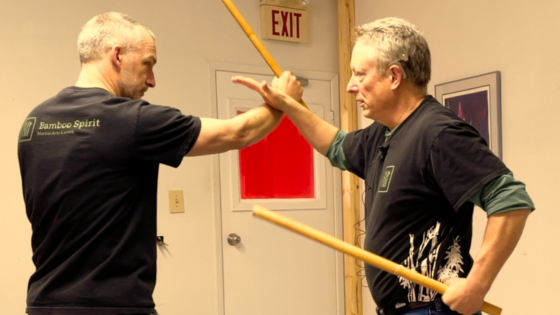How to Fix The Wet Noodle
The “wet noodle” version of feeding a training partner is a fairly common problem encountered by martial arts instructors. I have seen variations of this problem among children and adults. In this post, I discuss the causes behind poor feeding and offer solutions on how to fix it.
First, the “wet noodle” denotes a weak feed or a feed with zero energy. The below video illustrates this problem.
If you are not able to view this video, click here.
When it comes to the “wet noodle” issue, I think prevention and correction are key.
Prevention
Among beginners, the “wet noodle” problem usually stems from inexperience. They are also concerned that they don’t have sufficient control of their cane and may, therefore, injure their training partner.
With respect to inexperience, beginners have hardly swung a stick in their lives. This is especially true with children. They are not sure how to correctly feed their partner with good form and intent. Heck, many are just unsure of their control.
To prevent the “wet noodle” issue, I have found that single sinawali is a very useful introduction to using canes. The purpose of single sinawali is to introduce them to the feel of holding canes and striking their canes against their partner’s canes. Once the student gets the hang of single sinawali, I will then introduce them to the 12 angles of attack. I emphasize slow, steady, and smooth movement with a partner standing in front of them for target practice.
Once they have the 12 angles down, I then have them feed me the 12 angles while I execute the block, check, counter drill. I monitor them to ensure they are performing the attacks clearly, confidently, and with intent.
If you are not able to view this video, click here.
One step in preventing the “wet noodle” issue is teaching students to feed properly with an instructor.
Correction
For the advanced students, the “wet noodle” issue may stem from a lack of confidence, boredom, or disrespect for their training partner. Discovering the cause of the wet noodle issue among the advanced students may inform one’s approach to the issue. Let’s address the above issues in turn.
Lack of Confidence: This can come about in a couple of ways. First, the feeder just may not be confident in their feeding technique at all. Naturally, this occurs more often among beginners, particularly those who have no martial arts experience whatsoever. One way to fix this issue is to pair this student up with a trustworthy senior student who will guide and encourage the beginner to develop good feeding habits.
However, sometimes the issue is not so much the feeder as much as the training partner. I have witnessed “wet noodle” situations where I realized that the issue was not so much the feeder as much as the training partner. One variation of this scenario is where the feeder is matching the energy of the training partner. More specifically, the training partner’s defensive technique is weak and is “wet noodles”. Unfortunately, the feeder is matching this energy. You, as the instructor, have to step in and break this cycle. I often intervene and have each pair up with a different partner.
More specifically, the training partner’s weak defensive technique is “wet noodles.” Unfortunately, the feeder is matching this energy.
As the instructor, you must step in and break this cycle. I often intervene and have each pair up with a different partner (and, therefore, working with partners with different energy).
In the other scenario, the “wet noodle” feeder is intimidated by their training partner’s unsafe and aggressive energy. The feeder may feel like they are dancing on the edge of a cliff as far as a potential injury is concerned. The “wet noodle” may be an unconscious effort by the feeder to ratchet down their partner’s aggressive energy.
One of two things needs to happen here. Either the feeder asserts himself/herself and communicates to the training partner that they need to dial back their energy or exercise more safety in their technique, or inform the instructor. Whether the instructor has been informed or has observed the situation at this point needs to intervene and correct the situation.
Boredom: The feeder may just be bored. Is that feeder bored with practicing the same drill over and over? Or is she bored with practicing with the same partner? The solution could be as simple as changing partners or the drill up.
Or the boredom could be a sign of disrespect for a training partner.
It happens, and as an instructor, this is maddening. It’s one thing to feed a slow, deliberate attack with great form so that the training partner can learn a technique sequence. But it’s another to launch a sloppy attack with a seeming lack of interest in their partner’s development as a martial artist.
For example, I’ve heard many stories from women, particularly about their male partners “taking it easy” on them. There could be several reasons for this, ranging from the discomfort of working with a woman to not wanting “to hurt them” in the belief that they are too delicate. Or it could be that they do not know what to do.
Well, duh. “Just feed them the same way you feed your buddies.”
When we are in class, we contribute to each other’s martial development. Most of my students are interested in self-preservation, self-defense, and personal development. I daresay that they will feel that they are not meeting their goals if they work with partners who engage in “wet noodle” training.
I have made it clear to my students that if they have any issues with any training partner, they need to first speak with their training partner.
If the student does not feel comfortable broaching this issue with their training partner, they know that they can confidentially discuss the matter with me. I will then discuss it with the problem student.
I look out for the “wet noodle” issue in class and have seen it occasionally. Fortunately, most of the time, it stems from a lapse in focus and loss of form. A brief reminder usually remedies the issue.
On the negative side of the ledger, I have had one student consistently practice the “wet noodle” version of feeding, and I addressed it with him several times. In the end, the student stopped coming to class. Not surprisingly, most students had no interest in training with him.
In summary, I believe that the two-pronged strategy of prevention and correction should address most “wet noodle” issues that may arise in class. In addition, it pays to be proactive and tell the students that this will not be tolerated.
Over to the instructors and students: how do you fix the wet noodle?
Additional Reading
- Countering the Punyo Feed
- High or Low Energy Private Lessons
- The Third Lockdown
- Fix It Friday: Which Way?
- 7 Benefits of Changing Martial Arts Partners
Share this post:
- Click to share on X (Opens in new window) X
- Click to share on Facebook (Opens in new window) Facebook
- Click to share on LinkedIn (Opens in new window) LinkedIn
- Click to share on Threads (Opens in new window) Threads
- Click to share on WhatsApp (Opens in new window) WhatsApp
- Click to email a link to a friend (Opens in new window) Email
- Click to share on Pinterest (Opens in new window) Pinterest
Related
Tags In
Brian Johns
Related Posts
2 Comments
Leave a ReplyCancel reply
Categories
- Arnis/Kali/Eskrima (136)
- Book Review (8)
- DVD Reviews (3)
- Guest Post (4)
- Inspiration (24)
- Martial Arts (113)
- My story (96)
- Safety (15)
- Tips & tricks (6)
- Uncategorized (3)
- YouTube Videos (8)






[…] (1) Angles of attack: I teach the 12 angles of attack. There are several details that I work on, including footwork and chambering. One example is in the below video where I discuss the transition between angles 1 and 2. Knowing the 12 angles of attack is a precursor to learning how to feed effectively. […]
[…] those who train with them, I start with basics, such as the angles of attack. Feeding random angles of attack to a defender is an example of a modified live training […]